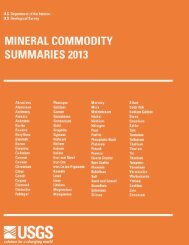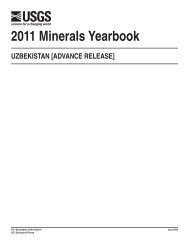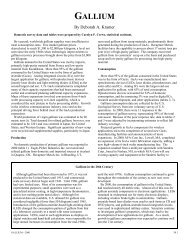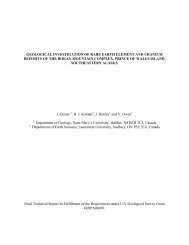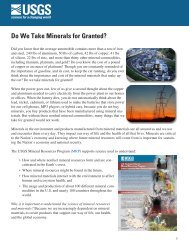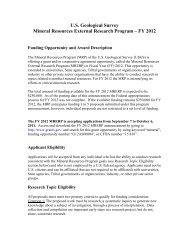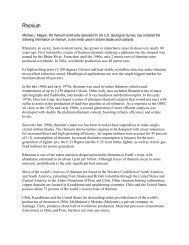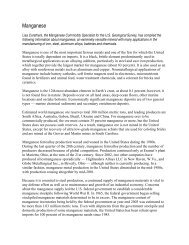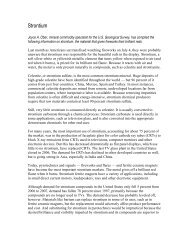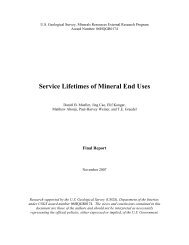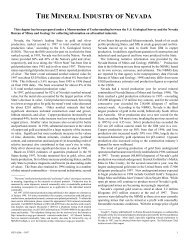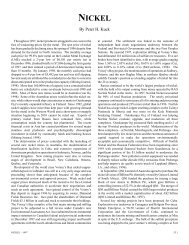Mineral Commodity Summaries 2003 - Mineral Resources Program ...
Mineral Commodity Summaries 2003 - Mineral Resources Program ...
Mineral Commodity Summaries 2003 - Mineral Resources Program ...
Create successful ePaper yourself
Turn your PDF publications into a flip-book with our unique Google optimized e-Paper software.
1 Based on U.S. Geological Survey Circular 831, 1980.<br />
APPENDIX C<br />
A Resource/Reserve Classification for <strong>Mineral</strong>s 1<br />
Through the years, geologists, mining engineers, and<br />
others operating in the minerals field have used various<br />
terms to describe and classify mineral resources, which<br />
as defined herein include energy materials. Some of<br />
these terms have gained wide use and acceptance,<br />
although they are not always used with precisely the<br />
same meaning.<br />
The U.S. Geological Survey collects information about<br />
the quantity and quality of all mineral resources. In<br />
1976, the Survey and the U.S. Bureau of Mines<br />
developed a common classification and nomenclature,<br />
which was published as U.S. Geological Survey Bulletin<br />
1450-A—“Principles of the <strong>Mineral</strong> Resource<br />
Classification System of the U.S. Bureau of Mines and<br />
U.S. Geological Survey.” Experience with this resource<br />
classification system showed that some changes were<br />
necessary in order to make it more workable in practice<br />
and more useful in long-term planning. Therefore,<br />
representatives of the U.S. Geological Survey and the<br />
U.S. Bureau of Mines collaborated to revise Bulletin<br />
1450-A. Their work was published in 1980 as U.S.<br />
Geological Survey Circular 831—“Principles of a<br />
Resource/Reserve Classification for <strong>Mineral</strong>s.”<br />
Long-term public and commercial planning must be<br />
based on the probability of discovering new deposits, on<br />
developing economic extraction processes for currently<br />
unworkable deposits, and on knowing which resources<br />
are immediately available. Thus, resources must be<br />
continuously reassessed in the light of new geologic<br />
knowledge, of progress in science and technology, and<br />
of shifts in economic and political conditions. To best<br />
serve these planning needs, known resources should be<br />
classified from two standpoints: (1) purely geologic or<br />
physical/chemical characteristics—such as grade,<br />
quality tonnage, thickness, and depth—of the material in<br />
place: and (2) profitability analyses based on costs of<br />
extracting and marketing the material in a given<br />
economy at a given time. The former constitutes<br />
important objective scientific information of the resource<br />
and a relatively unchanging foundation upon which the<br />
latter more valuable economic delineation can be based.<br />
The revised classification systems, designed<br />
generally for all mineral materials, is shown graphically<br />
in figures 1 and 2; their components and usage are<br />
described in the text. The classification of mineral and<br />
energy resources is necessarily arbitrary, because<br />
definitional criteria do not always coincide with natural<br />
boundaries. The system can be used to report the<br />
status of mineral and energy-fuel resources for the<br />
Nation or for specific areas.<br />
RESOURCE/RESERVE DEFINITIONS<br />
A dictionary definition of resource, “something in<br />
reserve or ready if needed,” has been adapted for<br />
INTRODUCTION<br />
195<br />
mineral and energy resources to comprise all materials,<br />
including those only surmised to exist, that have present<br />
to anticipated future value.<br />
Resource.—A concentration of naturally occurring solid,<br />
liquid, or gaseous material in or on the Earth’s crust in<br />
such form and amount that economic extraction of a<br />
commodity from the concentration is currently or<br />
potentially feasible.<br />
Original Resource.—The amount of a resource before<br />
production.<br />
Identified <strong>Resources</strong>.—<strong>Resources</strong> whose location,<br />
grade, quality, and quantity are known or estimated<br />
from specific geologic evidence. Identified resources<br />
include economic, marginally economic, and subeconomic<br />
components. To reflect varying degrees of<br />
geologic certainty, these economic divisions can be<br />
subdivided into measured, indicated, and inferred.<br />
Demonstrated.—A term for the sum of measured<br />
plus indicated.<br />
Measured.—Quantity is computed from<br />
dimensions revealed in outcrops, trenches,<br />
workings, or drill holes; grade and(or) quality are<br />
computed from the results of detailed sampling.<br />
The sites for inspection, sampling, and<br />
measurements are spaced so closely and the<br />
geologic character is so well defined that size,<br />
shape, depth, and mineral content of the<br />
resource are well established.<br />
Indicated.—Quantity and grade and(or) quality are<br />
computed from information similar to that used<br />
for measured resources, but the sites for<br />
inspection, sampling, measurement are farther<br />
apart or are otherwise less adequately spaced.<br />
The degree of assurance, although lower than<br />
that for measured resources, is high enough to<br />
assume continuity between points of<br />
observation.<br />
Inferred.—Estimates are based on an assumed<br />
continuity beyond measured and(or) indicated<br />
resources, for which there is geologic evidence.<br />
Inferred resources may or may not be supported<br />
by samples or measurements.<br />
Reserve Base.—That part of an identified resource that<br />
meets specified minimum physical and chemical<br />
criteria related to current mining and production<br />
practices, including those for grade, quality,<br />
thickness, and depth. The reserve base is the<br />
in-place demonstrated (measured plus indicated)<br />
resource from which reserves are estimated. It may<br />
encompass those parts of the resources that have a<br />
reasonable potential for becoming economically<br />
available within planning horizons beyond those that<br />
assume proven technology and current economics.<br />
The reserve base includes those resources that are<br />
currently economic (reserves), marginally economic



